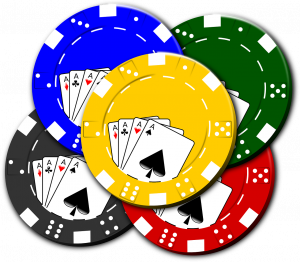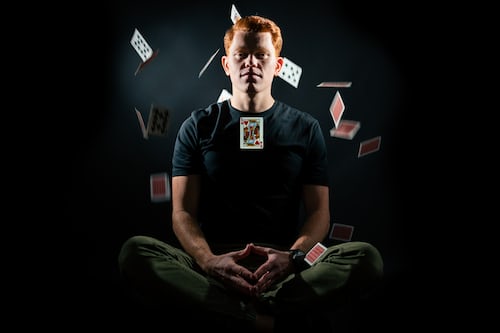Poker is a game that has been enjoyed by millions of people around the world for centuries. While many people view it as a simple game of chance, there is actually a great deal of skill and strategy involved in playing poker. In addition to its gameplay, poker has also inspired a number of fascinating artistic connections over the years. From literature and film to music and visual art, poker has been a source of inspiration for many creative minds. In this article, we will explore some of the most interesting artistic connections of poker and how they have influenced popular culture.
The Intersection of Poker and Art: A Look at the Most Creative Poker Tables
Poker is a game that has been around for centuries, and it has always been associated with a certain level of sophistication and elegance. It is a game that requires skill, strategy, and a bit of luck, and it has been played by some of the most famous and influential people in history. But did you know that poker has also inspired some of the most creative and artistic minds in the world? Here, we will take a look at some of the most fascinating artistic connections of poker, and explore the most creative poker tables that have ever been created.
One of the most interesting things about poker is that it has inspired artists from all over the world to create unique and beautiful poker tables. These tables are not only functional, but they are also works of art that showcase the creativity and imagination of their creators. Some of the most creative poker tables are made from unusual materials, such as glass, metal, or even wood. Others are designed to look like works of art, with intricate patterns and designs that are sure to impress anyone who sees them.
One of the most famous examples of a creative poker table is the one created by artist Maurizio Cattelan. This table is made from solid marble, and it features a life-sized sculpture of a hand holding a deck of cards. The hand is positioned in such a way that it appears to be dealing the cards, and the overall effect is both striking and surreal. This table is a true work of art, and it is sure to be the centerpiece of any room in which it is placed.
Another creative poker table that has gained a lot of attention in recent years is the one created by artist Eric So. This table is made from solid wood, and it features a unique design that is both functional and beautiful. The table is designed to look like a giant poker chip, with the top of the table serving as the playing surface. The chip is made from a combination of different woods, and it is finished with a high-gloss lacquer that gives it a beautiful shine. This table is a true masterpiece, and it is sure to impress anyone who sees it.
Of course, not all creative poker tables are designed to look like works of art. Some are designed to be functional and practical, while still incorporating unique and interesting design elements. For example, the poker table created by designer Lee J. Rowland is a perfect example of this. This table is made from solid wood, and it features a simple and elegant design that is both functional and beautiful. The table is designed to be easily disassembled and transported, making it perfect for players who want to take their game on the road.
The artistic connections of poker are truly fascinating, and they have inspired some of the most creative and beautiful poker tables that have ever been created. Whether you are a serious poker player or simply appreciate the beauty of art and design, these tables are sure to impress and inspire you. So why not take a closer look at some of the most creative poker tables out there, and discover the fascinating world of poker-inspired art and design?
From Paintings to Poker: The Artistic Evolution of Card Design

The earliest known playing cards were created in China during the Tang dynasty, around the 9th century. These cards were hand-painted and featured various designs, including animals, flowers, and landscapes. As playing cards spread throughout the world, they began to take on different designs and styles.
In Europe, playing cards became popular during the 14th century. These cards were often hand-painted and featured intricate designs, such as the court cards that depicted kings, queens, and knights. As printing technology improved, playing cards became more widely available and affordable. This led to the development of standardized designs, such as the French suits that are still used in many parts of the world today.
One of the most fascinating aspects of playing card design is the way that it has been influenced by art movements throughout history. For example, during the Art Nouveau period in the late 19th and early 20th centuries, playing cards featured flowing, organic designs that were inspired by nature. These cards were often highly decorative and featured intricate details.
Similarly, during the Art Deco period in the 1920s and 1930s, playing cards took on a more streamlined, geometric design. These cards were often bold and colorful, with simple shapes and patterns. The Art Deco style was also reflected in other areas of design, such as architecture and fashion.
In recent years, playing card design has continued to evolve. Many designers have taken inspiration from popular culture, such as movies, TV shows, and video games. For example, there are now playing cards that feature characters from Star Wars, Game of Thrones, and other popular franchises.
Another interesting trend in playing card design is the use of custom illustrations. Many designers now create their own unique designs for playing cards, often featuring original artwork and creative themes. These cards are often highly collectible and sought after by enthusiasts.
Of course, playing cards are not the only way that poker has influenced art. Many artists have been inspired by the game itself, creating paintings and other works that depict poker players and scenes from the game. One of the most famous examples is the painting “A Friend in Need” by Cassius Marcellus Coolidge, which features a group of dogs playing poker.
The artistic connections of poker are fascinating and far-reaching. From the earliest hand-painted cards to the latest custom designs, playing card design has been influenced by art movements throughout history. Similarly, many artists have been inspired by the game of poker itself, creating works that capture the excitement and drama of the game. Whether you are a poker player or an art enthusiast, there is no denying the impact that poker has had on the artistic world.
Poker as Inspiration: How Artists Have Incorporated the Game into Their Work
One of the most famous examples of poker in art is the painting “A Friend in Need” by Cassius Marcellus Coolidge. This painting, also known as “Dogs Playing Poker,” depicts a group of dogs sitting around a table playing poker. The painting has become a pop culture icon and has been referenced in movies, TV shows, and even video games.
But Coolidge’s painting is not the only example of poker in art. Many other artists have used the game as inspiration for their work. For example, the artist David Hockney created a series of paintings called “The Card Players” in the 1960s. These paintings depict men playing cards, including poker, in a variety of settings. The paintings are known for their bright colors and bold brushstrokes.
Another artist who has incorporated poker into his work is the sculptor Jeff Koons. Koons created a sculpture called “Balloon Dog (Yellow)” in 1994, which depicts a yellow dog made out of stainless steel. The sculpture has become one of Koons’ most famous works and has been exhibited in museums around the world.
Poker has also been used as a theme in literature. One of the most famous examples is the novel “The Cincinnati Kid” by Richard Jessup. The novel tells the story of a young poker player named Eric “The Kid” Stoner who is trying to become the best poker player in the world. The novel was later adapted into a movie starring Steve McQueen.
In addition to inspiring artists, poker has also been used as a tool for artists to connect with each other. Many artists have organized poker games as a way to socialize and network with other artists. For example, the artist Salvador Dali was known for hosting poker games at his home in Spain, where he would invite other artists and intellectuals to play.
Poker has also been used as a way for artists to raise money for charity. Many artists have organized poker tournaments to raise money for various causes. For example, the actor Ben Affleck has organized several poker tournaments to raise money for the Eastern Congo Initiative, a charity that he co-founded.
Poker has had a fascinating connection to the world of art. From paintings to sculptures to literature, the game has inspired artists in many different ways. Whether it’s through the use of poker as a theme in their work or as a tool for socializing and networking, artists have found creative ways to incorporate the game into their lives. So the next time you sit down to play a game of poker, remember that you are part of a rich artistic tradition that has been around for centuries.
The Art of Bluffing: A Study of Poker’s Psychological Tactics
Bluffing is a tactic that is used in poker to deceive opponents into thinking that you have a better hand than you actually do. It is a psychological game that requires players to read their opponents’ body language, facial expressions, and betting patterns to determine whether they are bluffing or not. The art of bluffing is not just about lying or deceiving; it is about using your creativity and imagination to create a convincing story that will make your opponents believe that you have a strong hand.
In the world of art, bluffing is also a common tactic used by artists to create an illusion or deceive the viewer. For example, in the painting “The Ambassadors” by Hans Holbein the Younger, there is a distorted skull in the foreground that can only be seen from a certain angle. This is a clever use of perspective that creates an illusion and deceives the viewer into thinking that the skull is a real object in the painting.
Similarly, in poker, players use various tactics to create an illusion and deceive their opponents. One of the most common tactics is the use of a poker face, where players keep a straight face and do not show any emotion, even when they have a weak hand. This creates an illusion of strength and confidence, which can intimidate opponents and make them fold their hands.
Another tactic used in poker is the use of body language. Players can use their body language to convey a message to their opponents, such as a fake smile or a nervous twitch. This can create an illusion of weakness or strength, depending on the message that the player wants to convey.
In the world of art, body language is also an important element that artists use to convey a message to the viewer. For example, in the sculpture “The Thinker” by Auguste Rodin, the body language of the figure conveys a sense of deep thought and contemplation. This creates an emotional connection between the viewer and the sculpture, and it is a powerful example of how body language can be used to convey a message.
The art of bluffing in poker is a fascinating study of psychology and creativity. It is a game that requires players to use their imagination and deception to create an illusion of strength or weakness. The connections between poker and art are evident in the use of tactics such as perspective, body language, and storytelling. Whether you are a poker player or an art enthusiast, the art of bluffing is a fascinating subject that is worth exploring. So, the next time you play poker or visit an art museum, remember the fascinating connections between these two worlds.
Poker and Pop Culture: The Influence of the Game on Music, Film, and Television

One of the most significant ways that poker has influenced pop culture is through music. Many musicians have written songs about poker, and some have even used the game as a metaphor for life. For example, Kenny Rogers’ hit song “The Gambler” is a classic example of how poker has influenced music. The song’s lyrics tell the story of a gambler who gives advice to a young man on how to play the game of poker and how to live life. The song’s chorus, “You’ve got to know when to hold ’em, know when to fold ’em, know when to walk away, and know when to run,” has become a popular catchphrase that is often used in everyday life.
Poker has also influenced the film industry. Many movies have been made about poker, and the game has been used as a plot device in many films. One of the most famous poker movies is “Rounders,” which stars Matt Damon and Edward Norton. The movie tells the story of two friends who are trying to make it big in the world of underground poker. The film’s popularity has led to an increase in the number of people playing poker, and it has also inspired many other poker movies.
Television has also been influenced by poker. Many TV shows have featured poker games, and some have even had entire episodes dedicated to the game. One of the most popular TV shows that feature poker is “Celebrity Poker Showdown.” The show features celebrities playing poker for charity, and it has become a hit with viewers. The show’s popularity has led to an increase in the number of people playing poker, and it has also helped to raise money for many charities.
In addition to music, film, and television, poker has also influenced art. Many artists have used poker as a subject in their work, and some have even created entire collections based on the game. For example, the artist Eric Fischl has created a series of paintings that depict people playing poker. The paintings are a commentary on the human condition and how we interact with each other.
In conclusion, poker has had a significant influence on pop culture. From music to film to television to art, the game has been used as a subject in many different forms of artistic expression. The game’s popularity has led to an increase in the number of people playing poker, and it has also helped to raise money for many charities. Whether you are a fan of poker or not, it is clear that the game has had a lasting impact on our culture.
